Understanding Residency Status and Business Activities in Taxation Law
VerifiedAdded on 2023/02/01
|13
|3345
|39
AI Summary
This article explores the residency status of individuals employed in luxury cruise liners and the taxation implications. It discusses the different residency tests and applies them to a case study. It also examines the classification of receipts from business activities under taxation law.
Contribute Materials
Your contribution can guide someone’s learning journey. Share your
documents today.
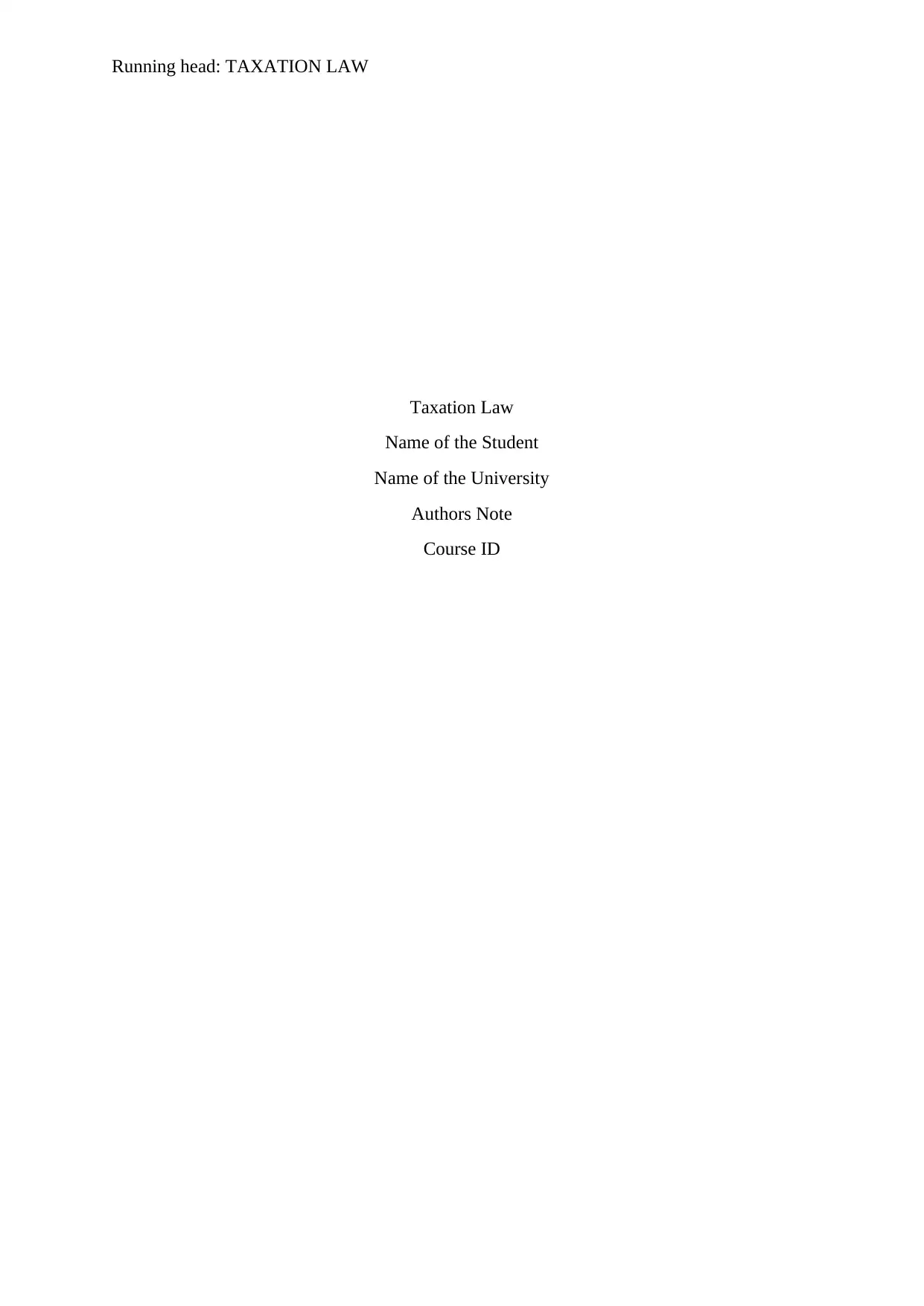
Running head: TAXATION LAW
Taxation Law
Name of the Student
Name of the University
Authors Note
Course ID
Taxation Law
Name of the Student
Name of the University
Authors Note
Course ID
Secure Best Marks with AI Grader
Need help grading? Try our AI Grader for instant feedback on your assignments.
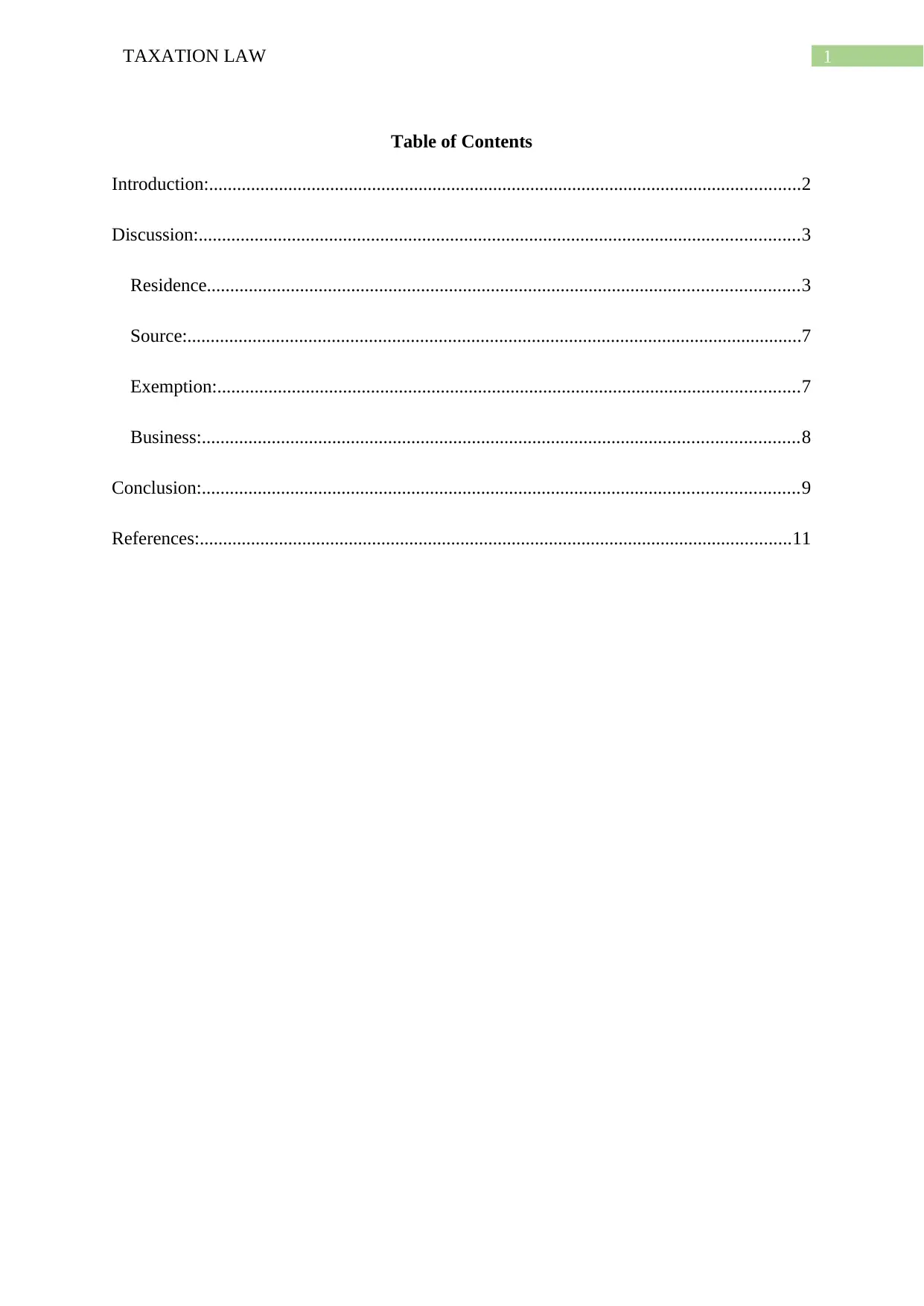
1TAXATION LAW
Table of Contents
Introduction:...............................................................................................................................2
Discussion:.................................................................................................................................3
Residence...............................................................................................................................3
Source:....................................................................................................................................7
Exemption:.............................................................................................................................7
Business:................................................................................................................................8
Conclusion:................................................................................................................................9
References:...............................................................................................................................11
Table of Contents
Introduction:...............................................................................................................................2
Discussion:.................................................................................................................................3
Residence...............................................................................................................................3
Source:....................................................................................................................................7
Exemption:.............................................................................................................................7
Business:................................................................................................................................8
Conclusion:................................................................................................................................9
References:...............................................................................................................................11
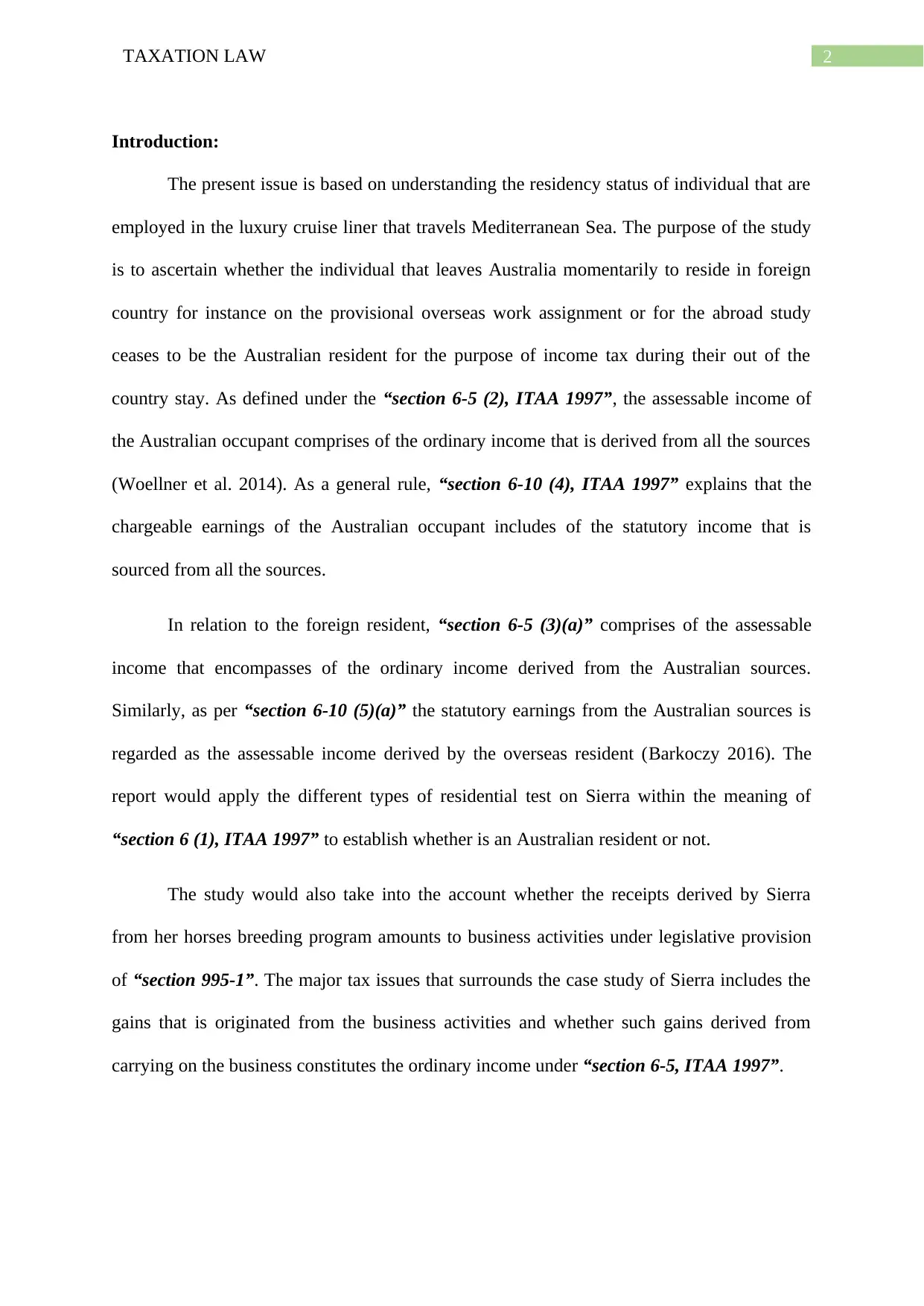
2TAXATION LAW
Introduction:
The present issue is based on understanding the residency status of individual that are
employed in the luxury cruise liner that travels Mediterranean Sea. The purpose of the study
is to ascertain whether the individual that leaves Australia momentarily to reside in foreign
country for instance on the provisional overseas work assignment or for the abroad study
ceases to be the Australian resident for the purpose of income tax during their out of the
country stay. As defined under the “section 6-5 (2), ITAA 1997”, the assessable income of
the Australian occupant comprises of the ordinary income that is derived from all the sources
(Woellner et al. 2014). As a general rule, “section 6-10 (4), ITAA 1997” explains that the
chargeable earnings of the Australian occupant includes of the statutory income that is
sourced from all the sources.
In relation to the foreign resident, “section 6-5 (3)(a)” comprises of the assessable
income that encompasses of the ordinary income derived from the Australian sources.
Similarly, as per “section 6-10 (5)(a)” the statutory earnings from the Australian sources is
regarded as the assessable income derived by the overseas resident (Barkoczy 2016). The
report would apply the different types of residential test on Sierra within the meaning of
“section 6 (1), ITAA 1997” to establish whether is an Australian resident or not.
The study would also take into the account whether the receipts derived by Sierra
from her horses breeding program amounts to business activities under legislative provision
of “section 995-1”. The major tax issues that surrounds the case study of Sierra includes the
gains that is originated from the business activities and whether such gains derived from
carrying on the business constitutes the ordinary income under “section 6-5, ITAA 1997”.
Introduction:
The present issue is based on understanding the residency status of individual that are
employed in the luxury cruise liner that travels Mediterranean Sea. The purpose of the study
is to ascertain whether the individual that leaves Australia momentarily to reside in foreign
country for instance on the provisional overseas work assignment or for the abroad study
ceases to be the Australian resident for the purpose of income tax during their out of the
country stay. As defined under the “section 6-5 (2), ITAA 1997”, the assessable income of
the Australian occupant comprises of the ordinary income that is derived from all the sources
(Woellner et al. 2014). As a general rule, “section 6-10 (4), ITAA 1997” explains that the
chargeable earnings of the Australian occupant includes of the statutory income that is
sourced from all the sources.
In relation to the foreign resident, “section 6-5 (3)(a)” comprises of the assessable
income that encompasses of the ordinary income derived from the Australian sources.
Similarly, as per “section 6-10 (5)(a)” the statutory earnings from the Australian sources is
regarded as the assessable income derived by the overseas resident (Barkoczy 2016). The
report would apply the different types of residential test on Sierra within the meaning of
“section 6 (1), ITAA 1997” to establish whether is an Australian resident or not.
The study would also take into the account whether the receipts derived by Sierra
from her horses breeding program amounts to business activities under legislative provision
of “section 995-1”. The major tax issues that surrounds the case study of Sierra includes the
gains that is originated from the business activities and whether such gains derived from
carrying on the business constitutes the ordinary income under “section 6-5, ITAA 1997”.
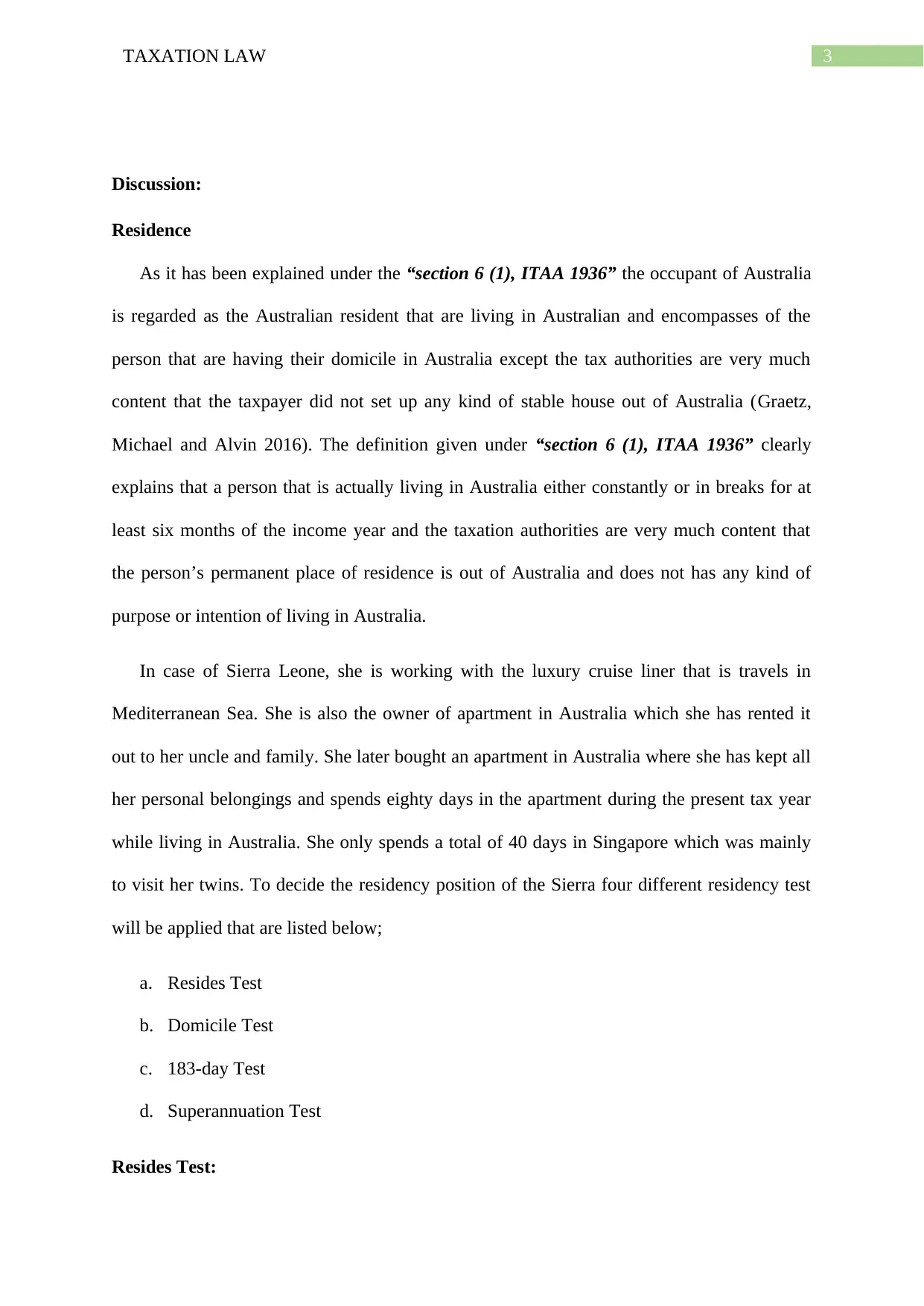
3TAXATION LAW
Discussion:
Residence
As it has been explained under the “section 6 (1), ITAA 1936” the occupant of Australia
is regarded as the Australian resident that are living in Australian and encompasses of the
person that are having their domicile in Australia except the tax authorities are very much
content that the taxpayer did not set up any kind of stable house out of Australia (Graetz,
Michael and Alvin 2016). The definition given under “section 6 (1), ITAA 1936” clearly
explains that a person that is actually living in Australia either constantly or in breaks for at
least six months of the income year and the taxation authorities are very much content that
the person’s permanent place of residence is out of Australia and does not has any kind of
purpose or intention of living in Australia.
In case of Sierra Leone, she is working with the luxury cruise liner that is travels in
Mediterranean Sea. She is also the owner of apartment in Australia which she has rented it
out to her uncle and family. She later bought an apartment in Australia where she has kept all
her personal belongings and spends eighty days in the apartment during the present tax year
while living in Australia. She only spends a total of 40 days in Singapore which was mainly
to visit her twins. To decide the residency position of the Sierra four different residency test
will be applied that are listed below;
a. Resides Test
b. Domicile Test
c. 183-day Test
d. Superannuation Test
Resides Test:
Discussion:
Residence
As it has been explained under the “section 6 (1), ITAA 1936” the occupant of Australia
is regarded as the Australian resident that are living in Australian and encompasses of the
person that are having their domicile in Australia except the tax authorities are very much
content that the taxpayer did not set up any kind of stable house out of Australia (Graetz,
Michael and Alvin 2016). The definition given under “section 6 (1), ITAA 1936” clearly
explains that a person that is actually living in Australia either constantly or in breaks for at
least six months of the income year and the taxation authorities are very much content that
the person’s permanent place of residence is out of Australia and does not has any kind of
purpose or intention of living in Australia.
In case of Sierra Leone, she is working with the luxury cruise liner that is travels in
Mediterranean Sea. She is also the owner of apartment in Australia which she has rented it
out to her uncle and family. She later bought an apartment in Australia where she has kept all
her personal belongings and spends eighty days in the apartment during the present tax year
while living in Australia. She only spends a total of 40 days in Singapore which was mainly
to visit her twins. To decide the residency position of the Sierra four different residency test
will be applied that are listed below;
a. Resides Test
b. Domicile Test
c. 183-day Test
d. Superannuation Test
Resides Test:
Secure Best Marks with AI Grader
Need help grading? Try our AI Grader for instant feedback on your assignments.
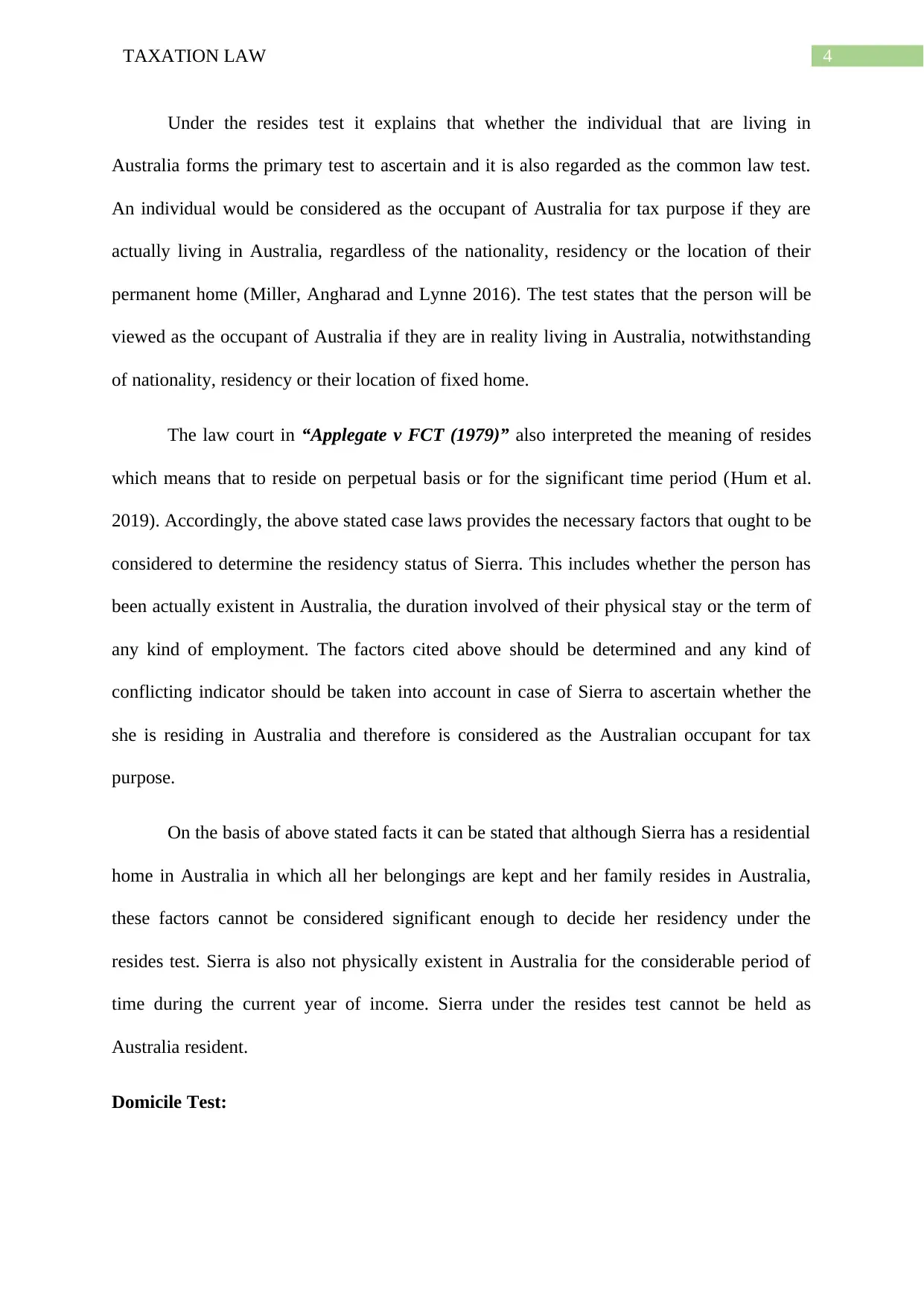
4TAXATION LAW
Under the resides test it explains that whether the individual that are living in
Australia forms the primary test to ascertain and it is also regarded as the common law test.
An individual would be considered as the occupant of Australia for tax purpose if they are
actually living in Australia, regardless of the nationality, residency or the location of their
permanent home (Miller, Angharad and Lynne 2016). The test states that the person will be
viewed as the occupant of Australia if they are in reality living in Australia, notwithstanding
of nationality, residency or their location of fixed home.
The law court in “Applegate v FCT (1979)” also interpreted the meaning of resides
which means that to reside on perpetual basis or for the significant time period (Hum et al.
2019). Accordingly, the above stated case laws provides the necessary factors that ought to be
considered to determine the residency status of Sierra. This includes whether the person has
been actually existent in Australia, the duration involved of their physical stay or the term of
any kind of employment. The factors cited above should be determined and any kind of
conflicting indicator should be taken into account in case of Sierra to ascertain whether the
she is residing in Australia and therefore is considered as the Australian occupant for tax
purpose.
On the basis of above stated facts it can be stated that although Sierra has a residential
home in Australia in which all her belongings are kept and her family resides in Australia,
these factors cannot be considered significant enough to decide her residency under the
resides test. Sierra is also not physically existent in Australia for the considerable period of
time during the current year of income. Sierra under the resides test cannot be held as
Australia resident.
Domicile Test:
Under the resides test it explains that whether the individual that are living in
Australia forms the primary test to ascertain and it is also regarded as the common law test.
An individual would be considered as the occupant of Australia for tax purpose if they are
actually living in Australia, regardless of the nationality, residency or the location of their
permanent home (Miller, Angharad and Lynne 2016). The test states that the person will be
viewed as the occupant of Australia if they are in reality living in Australia, notwithstanding
of nationality, residency or their location of fixed home.
The law court in “Applegate v FCT (1979)” also interpreted the meaning of resides
which means that to reside on perpetual basis or for the significant time period (Hum et al.
2019). Accordingly, the above stated case laws provides the necessary factors that ought to be
considered to determine the residency status of Sierra. This includes whether the person has
been actually existent in Australia, the duration involved of their physical stay or the term of
any kind of employment. The factors cited above should be determined and any kind of
conflicting indicator should be taken into account in case of Sierra to ascertain whether the
she is residing in Australia and therefore is considered as the Australian occupant for tax
purpose.
On the basis of above stated facts it can be stated that although Sierra has a residential
home in Australia in which all her belongings are kept and her family resides in Australia,
these factors cannot be considered significant enough to decide her residency under the
resides test. Sierra is also not physically existent in Australia for the considerable period of
time during the current year of income. Sierra under the resides test cannot be held as
Australia resident.
Domicile Test:

5TAXATION LAW
According to the Domicile Test defined under “Domicile Act 1982” the taxpayer has
the home defines the legal relationship with the country on the basis of which the person is
liable to invoke the laws of country as their own law (Morgan et al. 2018). A person’s
domicile represents the place where the permanent home is located and where the person
actually resides. With respect to the “section 6 (1), ITAA 1936” an individual is regarded as
the Australian occupant given they have their home in Australia excluding when they can
demonstrate that they have set up the perpetual abode out of Australia. The law court in
“FCT v Applegate (1979)” explained the meaning of perpetual place of residence (Robin
2019). The federal court noticed that despite the fact that the taxpayer had held the Australian
residence, he had established the permanent place of dwelling out of Australia.
Conferring to the “Taxation Ruling of IT 2650” there are certain factors that should
be considered in ascertaining whether the person that leaves Australia on the provisional
basis to live in the overseas obtains the perpetual home in the foreign country and hence stops
being resident of Australia all through their non-existence. The factors comprise of the actual
time of stay in the overseas country, the intention of taxpayer’s stay, the durability of a
taxpayer’s continuous association with the place and whether the taxpayer has set up any kind
of fixed home in the overseas country (Robin & Barkoczy 2019). The law court in “Boer v
FCT (2012)” and “Sully v FCT (2012)” the taxpayers were considered as the Australian
inhabitants all through their stay in the abroad since the taxpayer has not set up any
permanent place of residence out of Australia.
Mentioning to the above stated case, the domicile of Sierra is in Australia because she
has always resided in Australia and she will usually retain the domicile of Australia during
her overseas absence or employment with Cruise Liner. Factors such as the fixed home which
is her apartment in Australia and all of the personal belonging explains that she has the
permanent location of house in Australia. Citing the case of “FCT v Applegate (1979)” it can
According to the Domicile Test defined under “Domicile Act 1982” the taxpayer has
the home defines the legal relationship with the country on the basis of which the person is
liable to invoke the laws of country as their own law (Morgan et al. 2018). A person’s
domicile represents the place where the permanent home is located and where the person
actually resides. With respect to the “section 6 (1), ITAA 1936” an individual is regarded as
the Australian occupant given they have their home in Australia excluding when they can
demonstrate that they have set up the perpetual abode out of Australia. The law court in
“FCT v Applegate (1979)” explained the meaning of perpetual place of residence (Robin
2019). The federal court noticed that despite the fact that the taxpayer had held the Australian
residence, he had established the permanent place of dwelling out of Australia.
Conferring to the “Taxation Ruling of IT 2650” there are certain factors that should
be considered in ascertaining whether the person that leaves Australia on the provisional
basis to live in the overseas obtains the perpetual home in the foreign country and hence stops
being resident of Australia all through their non-existence. The factors comprise of the actual
time of stay in the overseas country, the intention of taxpayer’s stay, the durability of a
taxpayer’s continuous association with the place and whether the taxpayer has set up any kind
of fixed home in the overseas country (Robin & Barkoczy 2019). The law court in “Boer v
FCT (2012)” and “Sully v FCT (2012)” the taxpayers were considered as the Australian
inhabitants all through their stay in the abroad since the taxpayer has not set up any
permanent place of residence out of Australia.
Mentioning to the above stated case, the domicile of Sierra is in Australia because she
has always resided in Australia and she will usually retain the domicile of Australia during
her overseas absence or employment with Cruise Liner. Factors such as the fixed home which
is her apartment in Australia and all of the personal belonging explains that she has the
permanent location of house in Australia. Citing the case of “FCT v Applegate (1979)” it can
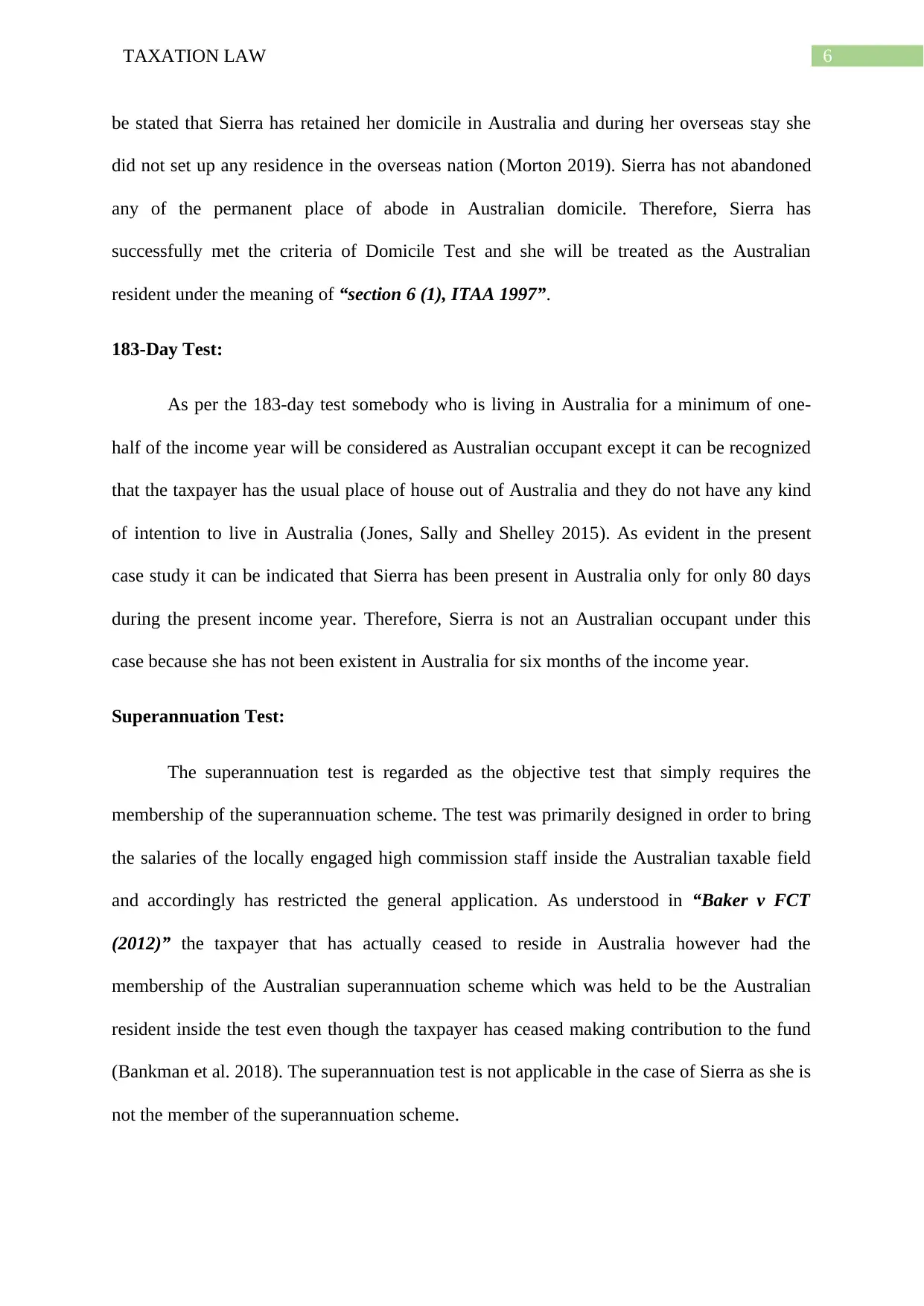
6TAXATION LAW
be stated that Sierra has retained her domicile in Australia and during her overseas stay she
did not set up any residence in the overseas nation (Morton 2019). Sierra has not abandoned
any of the permanent place of abode in Australian domicile. Therefore, Sierra has
successfully met the criteria of Domicile Test and she will be treated as the Australian
resident under the meaning of “section 6 (1), ITAA 1997”.
183-Day Test:
As per the 183-day test somebody who is living in Australia for a minimum of one-
half of the income year will be considered as Australian occupant except it can be recognized
that the taxpayer has the usual place of house out of Australia and they do not have any kind
of intention to live in Australia (Jones, Sally and Shelley 2015). As evident in the present
case study it can be indicated that Sierra has been present in Australia only for only 80 days
during the present income year. Therefore, Sierra is not an Australian occupant under this
case because she has not been existent in Australia for six months of the income year.
Superannuation Test:
The superannuation test is regarded as the objective test that simply requires the
membership of the superannuation scheme. The test was primarily designed in order to bring
the salaries of the locally engaged high commission staff inside the Australian taxable field
and accordingly has restricted the general application. As understood in “Baker v FCT
(2012)” the taxpayer that has actually ceased to reside in Australia however had the
membership of the Australian superannuation scheme which was held to be the Australian
resident inside the test even though the taxpayer has ceased making contribution to the fund
(Bankman et al. 2018). The superannuation test is not applicable in the case of Sierra as she is
not the member of the superannuation scheme.
be stated that Sierra has retained her domicile in Australia and during her overseas stay she
did not set up any residence in the overseas nation (Morton 2019). Sierra has not abandoned
any of the permanent place of abode in Australian domicile. Therefore, Sierra has
successfully met the criteria of Domicile Test and she will be treated as the Australian
resident under the meaning of “section 6 (1), ITAA 1997”.
183-Day Test:
As per the 183-day test somebody who is living in Australia for a minimum of one-
half of the income year will be considered as Australian occupant except it can be recognized
that the taxpayer has the usual place of house out of Australia and they do not have any kind
of intention to live in Australia (Jones, Sally and Shelley 2015). As evident in the present
case study it can be indicated that Sierra has been present in Australia only for only 80 days
during the present income year. Therefore, Sierra is not an Australian occupant under this
case because she has not been existent in Australia for six months of the income year.
Superannuation Test:
The superannuation test is regarded as the objective test that simply requires the
membership of the superannuation scheme. The test was primarily designed in order to bring
the salaries of the locally engaged high commission staff inside the Australian taxable field
and accordingly has restricted the general application. As understood in “Baker v FCT
(2012)” the taxpayer that has actually ceased to reside in Australia however had the
membership of the Australian superannuation scheme which was held to be the Australian
resident inside the test even though the taxpayer has ceased making contribution to the fund
(Bankman et al. 2018). The superannuation test is not applicable in the case of Sierra as she is
not the member of the superannuation scheme.
Paraphrase This Document
Need a fresh take? Get an instant paraphrase of this document with our AI Paraphraser

7TAXATION LAW
With respect to the above stated test it can be stated that Sierra has satisfied the
Domicile Test under the “Domicile Act 1982”. Therefore, she will be considered as the
Australian occupant under the meaning of “section 6 (1), ITAA 1997” during her overseas
stay in abroad.
Source:
As stated in the earlier discussion a non-resident of Australia is regarded as the only
subject to impose tax on the income derived from the Australian sources in terms of section
“subsection 6-5 (3)(a)” and “section 6-10(5)(a), ITAA 1997”. For the taxpayer that are non-
resident the sources of income would therefore be originally ascertained whether the
Australian taxing authority imposes tax (Oishi et al. 2018). The court in “French v FCT
(1957)” held that income that consists of the remuneration for the services rendered is
regularly sourced where the services are executed. However, in another case of “FCT v
Mitchum (1965)” there are some of the situations where the location of entering in the
contract may be considered more vital in ascertaining the source. The federal court stated that
even though the services are carried out in Australia, the contract of services made out of
Australia and the income was ascertained to be sourced out of Australia.
The evidences that has been obtained from the current case of Sierra it can be stated
that the contract was signed by Sierra outside Australia in Hong Kong, however the company
was set up in Bermuda. The salary that has been earned by Sierra is derived from rendering
services is outside of Australia. Similarly, by citing the case of “FCT v French (1957)” the
salary derived by the Sierra is out of Australia and as a result of this the income will not be
taxed in Australia so as to avoid the double taxation of Sierra salary (Schmalbeck et al. 2015).
With respect to the above stated test it can be stated that Sierra has satisfied the
Domicile Test under the “Domicile Act 1982”. Therefore, she will be considered as the
Australian occupant under the meaning of “section 6 (1), ITAA 1997” during her overseas
stay in abroad.
Source:
As stated in the earlier discussion a non-resident of Australia is regarded as the only
subject to impose tax on the income derived from the Australian sources in terms of section
“subsection 6-5 (3)(a)” and “section 6-10(5)(a), ITAA 1997”. For the taxpayer that are non-
resident the sources of income would therefore be originally ascertained whether the
Australian taxing authority imposes tax (Oishi et al. 2018). The court in “French v FCT
(1957)” held that income that consists of the remuneration for the services rendered is
regularly sourced where the services are executed. However, in another case of “FCT v
Mitchum (1965)” there are some of the situations where the location of entering in the
contract may be considered more vital in ascertaining the source. The federal court stated that
even though the services are carried out in Australia, the contract of services made out of
Australia and the income was ascertained to be sourced out of Australia.
The evidences that has been obtained from the current case of Sierra it can be stated
that the contract was signed by Sierra outside Australia in Hong Kong, however the company
was set up in Bermuda. The salary that has been earned by Sierra is derived from rendering
services is outside of Australia. Similarly, by citing the case of “FCT v French (1957)” the
salary derived by the Sierra is out of Australia and as a result of this the income will not be
taxed in Australia so as to avoid the double taxation of Sierra salary (Schmalbeck et al. 2015).
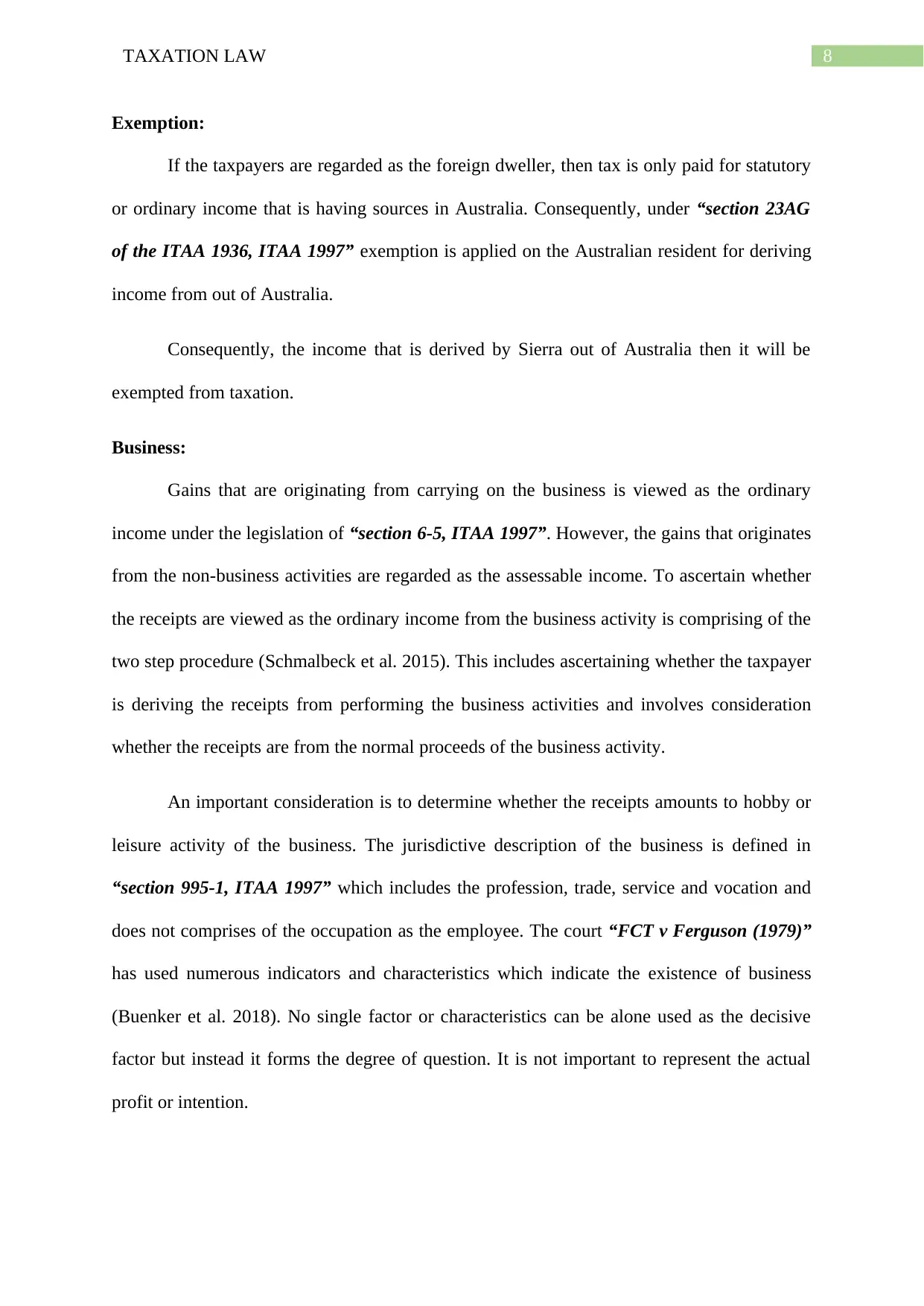
8TAXATION LAW
Exemption:
If the taxpayers are regarded as the foreign dweller, then tax is only paid for statutory
or ordinary income that is having sources in Australia. Consequently, under “section 23AG
of the ITAA 1936, ITAA 1997” exemption is applied on the Australian resident for deriving
income from out of Australia.
Consequently, the income that is derived by Sierra out of Australia then it will be
exempted from taxation.
Business:
Gains that are originating from carrying on the business is viewed as the ordinary
income under the legislation of “section 6-5, ITAA 1997”. However, the gains that originates
from the non-business activities are regarded as the assessable income. To ascertain whether
the receipts are viewed as the ordinary income from the business activity is comprising of the
two step procedure (Schmalbeck et al. 2015). This includes ascertaining whether the taxpayer
is deriving the receipts from performing the business activities and involves consideration
whether the receipts are from the normal proceeds of the business activity.
An important consideration is to determine whether the receipts amounts to hobby or
leisure activity of the business. The jurisdictive description of the business is defined in
“section 995-1, ITAA 1997” which includes the profession, trade, service and vocation and
does not comprises of the occupation as the employee. The court “FCT v Ferguson (1979)”
has used numerous indicators and characteristics which indicate the existence of business
(Buenker et al. 2018). No single factor or characteristics can be alone used as the decisive
factor but instead it forms the degree of question. It is not important to represent the actual
profit or intention.
Exemption:
If the taxpayers are regarded as the foreign dweller, then tax is only paid for statutory
or ordinary income that is having sources in Australia. Consequently, under “section 23AG
of the ITAA 1936, ITAA 1997” exemption is applied on the Australian resident for deriving
income from out of Australia.
Consequently, the income that is derived by Sierra out of Australia then it will be
exempted from taxation.
Business:
Gains that are originating from carrying on the business is viewed as the ordinary
income under the legislation of “section 6-5, ITAA 1997”. However, the gains that originates
from the non-business activities are regarded as the assessable income. To ascertain whether
the receipts are viewed as the ordinary income from the business activity is comprising of the
two step procedure (Schmalbeck et al. 2015). This includes ascertaining whether the taxpayer
is deriving the receipts from performing the business activities and involves consideration
whether the receipts are from the normal proceeds of the business activity.
An important consideration is to determine whether the receipts amounts to hobby or
leisure activity of the business. The jurisdictive description of the business is defined in
“section 995-1, ITAA 1997” which includes the profession, trade, service and vocation and
does not comprises of the occupation as the employee. The court “FCT v Ferguson (1979)”
has used numerous indicators and characteristics which indicate the existence of business
(Buenker et al. 2018). No single factor or characteristics can be alone used as the decisive
factor but instead it forms the degree of question. It is not important to represent the actual
profit or intention.
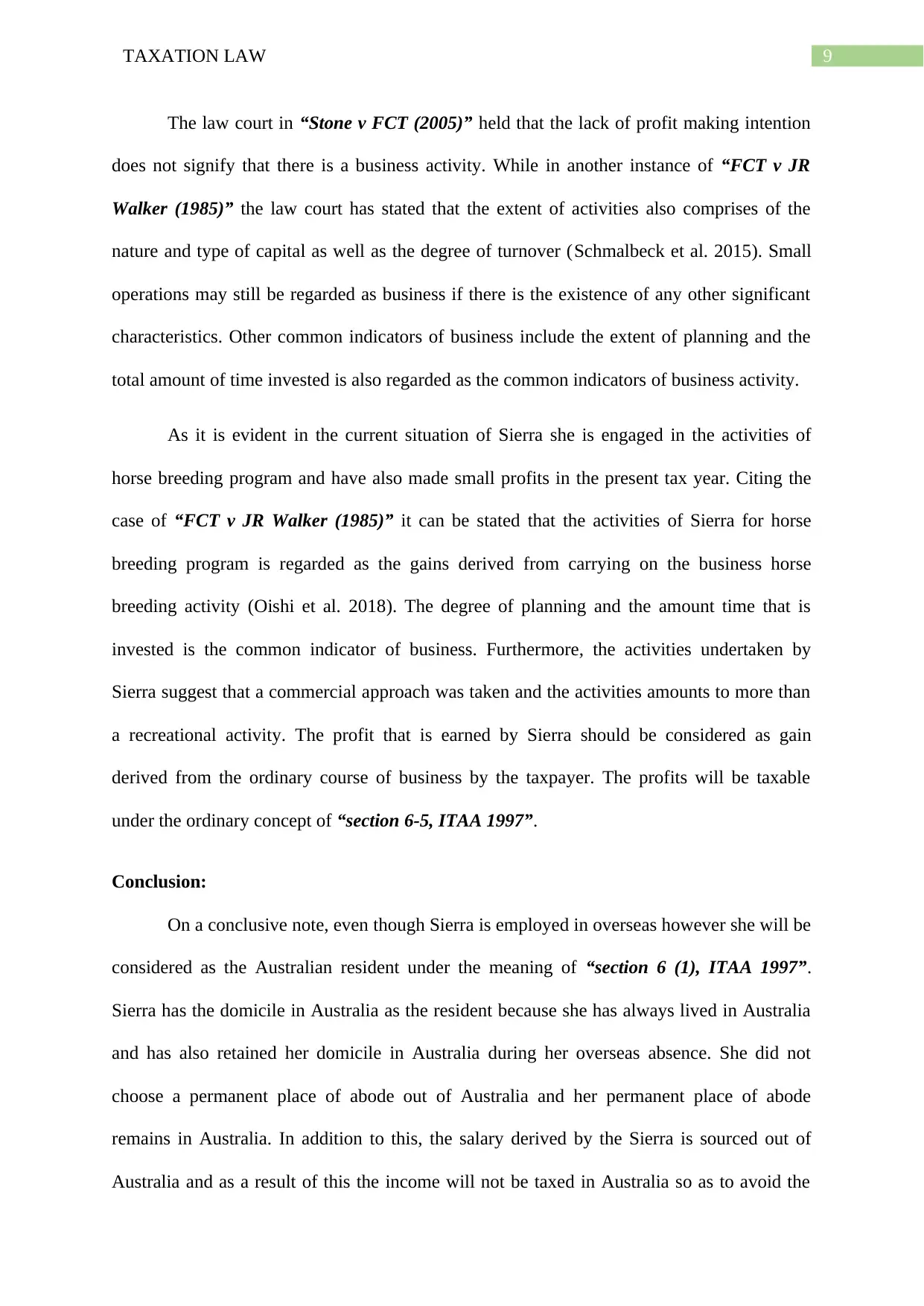
9TAXATION LAW
The law court in “Stone v FCT (2005)” held that the lack of profit making intention
does not signify that there is a business activity. While in another instance of “FCT v JR
Walker (1985)” the law court has stated that the extent of activities also comprises of the
nature and type of capital as well as the degree of turnover (Schmalbeck et al. 2015). Small
operations may still be regarded as business if there is the existence of any other significant
characteristics. Other common indicators of business include the extent of planning and the
total amount of time invested is also regarded as the common indicators of business activity.
As it is evident in the current situation of Sierra she is engaged in the activities of
horse breeding program and have also made small profits in the present tax year. Citing the
case of “FCT v JR Walker (1985)” it can be stated that the activities of Sierra for horse
breeding program is regarded as the gains derived from carrying on the business horse
breeding activity (Oishi et al. 2018). The degree of planning and the amount time that is
invested is the common indicator of business. Furthermore, the activities undertaken by
Sierra suggest that a commercial approach was taken and the activities amounts to more than
a recreational activity. The profit that is earned by Sierra should be considered as gain
derived from the ordinary course of business by the taxpayer. The profits will be taxable
under the ordinary concept of “section 6-5, ITAA 1997”.
Conclusion:
On a conclusive note, even though Sierra is employed in overseas however she will be
considered as the Australian resident under the meaning of “section 6 (1), ITAA 1997”.
Sierra has the domicile in Australia as the resident because she has always lived in Australia
and has also retained her domicile in Australia during her overseas absence. She did not
choose a permanent place of abode out of Australia and her permanent place of abode
remains in Australia. In addition to this, the salary derived by the Sierra is sourced out of
Australia and as a result of this the income will not be taxed in Australia so as to avoid the
The law court in “Stone v FCT (2005)” held that the lack of profit making intention
does not signify that there is a business activity. While in another instance of “FCT v JR
Walker (1985)” the law court has stated that the extent of activities also comprises of the
nature and type of capital as well as the degree of turnover (Schmalbeck et al. 2015). Small
operations may still be regarded as business if there is the existence of any other significant
characteristics. Other common indicators of business include the extent of planning and the
total amount of time invested is also regarded as the common indicators of business activity.
As it is evident in the current situation of Sierra she is engaged in the activities of
horse breeding program and have also made small profits in the present tax year. Citing the
case of “FCT v JR Walker (1985)” it can be stated that the activities of Sierra for horse
breeding program is regarded as the gains derived from carrying on the business horse
breeding activity (Oishi et al. 2018). The degree of planning and the amount time that is
invested is the common indicator of business. Furthermore, the activities undertaken by
Sierra suggest that a commercial approach was taken and the activities amounts to more than
a recreational activity. The profit that is earned by Sierra should be considered as gain
derived from the ordinary course of business by the taxpayer. The profits will be taxable
under the ordinary concept of “section 6-5, ITAA 1997”.
Conclusion:
On a conclusive note, even though Sierra is employed in overseas however she will be
considered as the Australian resident under the meaning of “section 6 (1), ITAA 1997”.
Sierra has the domicile in Australia as the resident because she has always lived in Australia
and has also retained her domicile in Australia during her overseas absence. She did not
choose a permanent place of abode out of Australia and her permanent place of abode
remains in Australia. In addition to this, the salary derived by the Sierra is sourced out of
Australia and as a result of this the income will not be taxed in Australia so as to avoid the
Secure Best Marks with AI Grader
Need help grading? Try our AI Grader for instant feedback on your assignments.
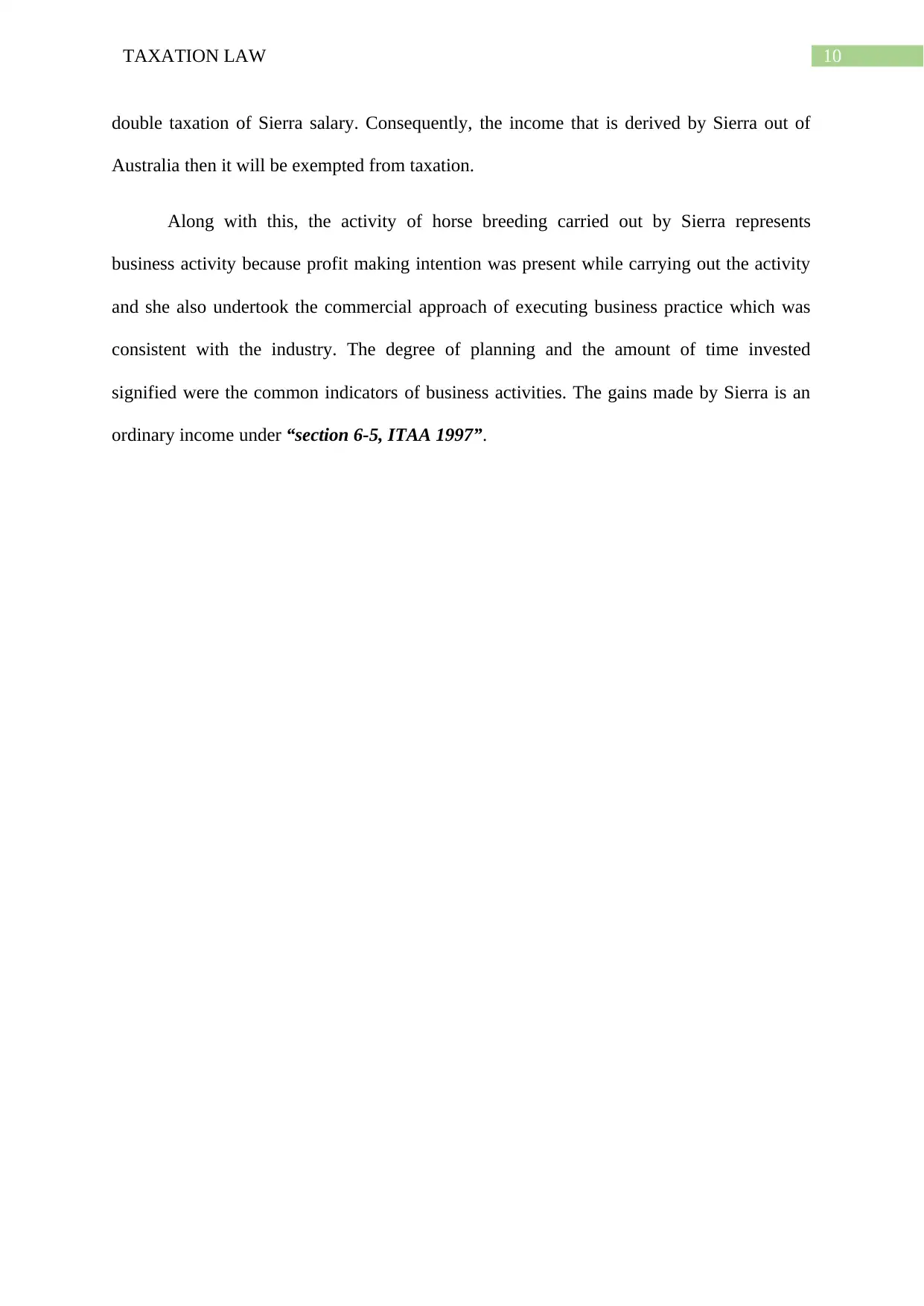
10TAXATION LAW
double taxation of Sierra salary. Consequently, the income that is derived by Sierra out of
Australia then it will be exempted from taxation.
Along with this, the activity of horse breeding carried out by Sierra represents
business activity because profit making intention was present while carrying out the activity
and she also undertook the commercial approach of executing business practice which was
consistent with the industry. The degree of planning and the amount of time invested
signified were the common indicators of business activities. The gains made by Sierra is an
ordinary income under “section 6-5, ITAA 1997”.
double taxation of Sierra salary. Consequently, the income that is derived by Sierra out of
Australia then it will be exempted from taxation.
Along with this, the activity of horse breeding carried out by Sierra represents
business activity because profit making intention was present while carrying out the activity
and she also undertook the commercial approach of executing business practice which was
consistent with the industry. The degree of planning and the amount of time invested
signified were the common indicators of business activities. The gains made by Sierra is an
ordinary income under “section 6-5, ITAA 1997”.
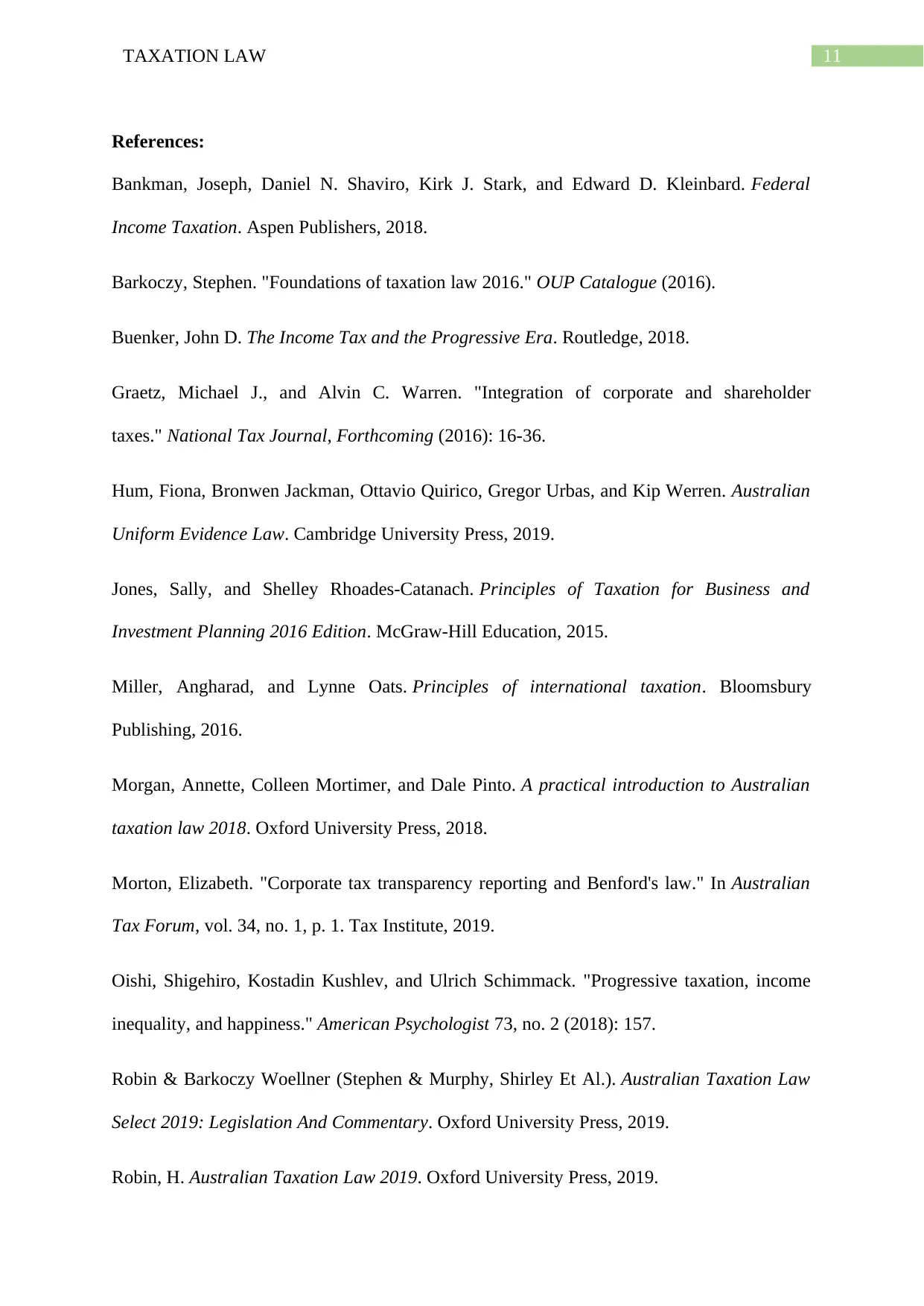
11TAXATION LAW
References:
Bankman, Joseph, Daniel N. Shaviro, Kirk J. Stark, and Edward D. Kleinbard. Federal
Income Taxation. Aspen Publishers, 2018.
Barkoczy, Stephen. "Foundations of taxation law 2016." OUP Catalogue (2016).
Buenker, John D. The Income Tax and the Progressive Era. Routledge, 2018.
Graetz, Michael J., and Alvin C. Warren. "Integration of corporate and shareholder
taxes." National Tax Journal, Forthcoming (2016): 16-36.
Hum, Fiona, Bronwen Jackman, Ottavio Quirico, Gregor Urbas, and Kip Werren. Australian
Uniform Evidence Law. Cambridge University Press, 2019.
Jones, Sally, and Shelley Rhoades-Catanach. Principles of Taxation for Business and
Investment Planning 2016 Edition. McGraw-Hill Education, 2015.
Miller, Angharad, and Lynne Oats. Principles of international taxation. Bloomsbury
Publishing, 2016.
Morgan, Annette, Colleen Mortimer, and Dale Pinto. A practical introduction to Australian
taxation law 2018. Oxford University Press, 2018.
Morton, Elizabeth. "Corporate tax transparency reporting and Benford's law." In Australian
Tax Forum, vol. 34, no. 1, p. 1. Tax Institute, 2019.
Oishi, Shigehiro, Kostadin Kushlev, and Ulrich Schimmack. "Progressive taxation, income
inequality, and happiness." American Psychologist 73, no. 2 (2018): 157.
Robin & Barkoczy Woellner (Stephen & Murphy, Shirley Et Al.). Australian Taxation Law
Select 2019: Legislation And Commentary. Oxford University Press, 2019.
Robin, H. Australian Taxation Law 2019. Oxford University Press, 2019.
References:
Bankman, Joseph, Daniel N. Shaviro, Kirk J. Stark, and Edward D. Kleinbard. Federal
Income Taxation. Aspen Publishers, 2018.
Barkoczy, Stephen. "Foundations of taxation law 2016." OUP Catalogue (2016).
Buenker, John D. The Income Tax and the Progressive Era. Routledge, 2018.
Graetz, Michael J., and Alvin C. Warren. "Integration of corporate and shareholder
taxes." National Tax Journal, Forthcoming (2016): 16-36.
Hum, Fiona, Bronwen Jackman, Ottavio Quirico, Gregor Urbas, and Kip Werren. Australian
Uniform Evidence Law. Cambridge University Press, 2019.
Jones, Sally, and Shelley Rhoades-Catanach. Principles of Taxation for Business and
Investment Planning 2016 Edition. McGraw-Hill Education, 2015.
Miller, Angharad, and Lynne Oats. Principles of international taxation. Bloomsbury
Publishing, 2016.
Morgan, Annette, Colleen Mortimer, and Dale Pinto. A practical introduction to Australian
taxation law 2018. Oxford University Press, 2018.
Morton, Elizabeth. "Corporate tax transparency reporting and Benford's law." In Australian
Tax Forum, vol. 34, no. 1, p. 1. Tax Institute, 2019.
Oishi, Shigehiro, Kostadin Kushlev, and Ulrich Schimmack. "Progressive taxation, income
inequality, and happiness." American Psychologist 73, no. 2 (2018): 157.
Robin & Barkoczy Woellner (Stephen & Murphy, Shirley Et Al.). Australian Taxation Law
Select 2019: Legislation And Commentary. Oxford University Press, 2019.
Robin, H. Australian Taxation Law 2019. Oxford University Press, 2019.

12TAXATION LAW
Schmalbeck, Richard, Lawrence Zelenak, and Sarah B. Lawsky. Federal Income Taxation.
Wolters Kluwer Law & Business, 2015.
Woellner, Robin, Stephen Barkoczy, Shirley Murphy, Christopher Evans, and Dale
Pinto. Australian Taxation Law 2014. 2014.
Schmalbeck, Richard, Lawrence Zelenak, and Sarah B. Lawsky. Federal Income Taxation.
Wolters Kluwer Law & Business, 2015.
Woellner, Robin, Stephen Barkoczy, Shirley Murphy, Christopher Evans, and Dale
Pinto. Australian Taxation Law 2014. 2014.
1 out of 13
Related Documents
Your All-in-One AI-Powered Toolkit for Academic Success.
+13062052269
info@desklib.com
Available 24*7 on WhatsApp / Email
![[object Object]](/_next/static/media/star-bottom.7253800d.svg)
Unlock your academic potential
© 2024 | Zucol Services PVT LTD | All rights reserved.





